1995 GMC SIERRA spare tire
[x] Cancel search: spare tirePage 259 of 488
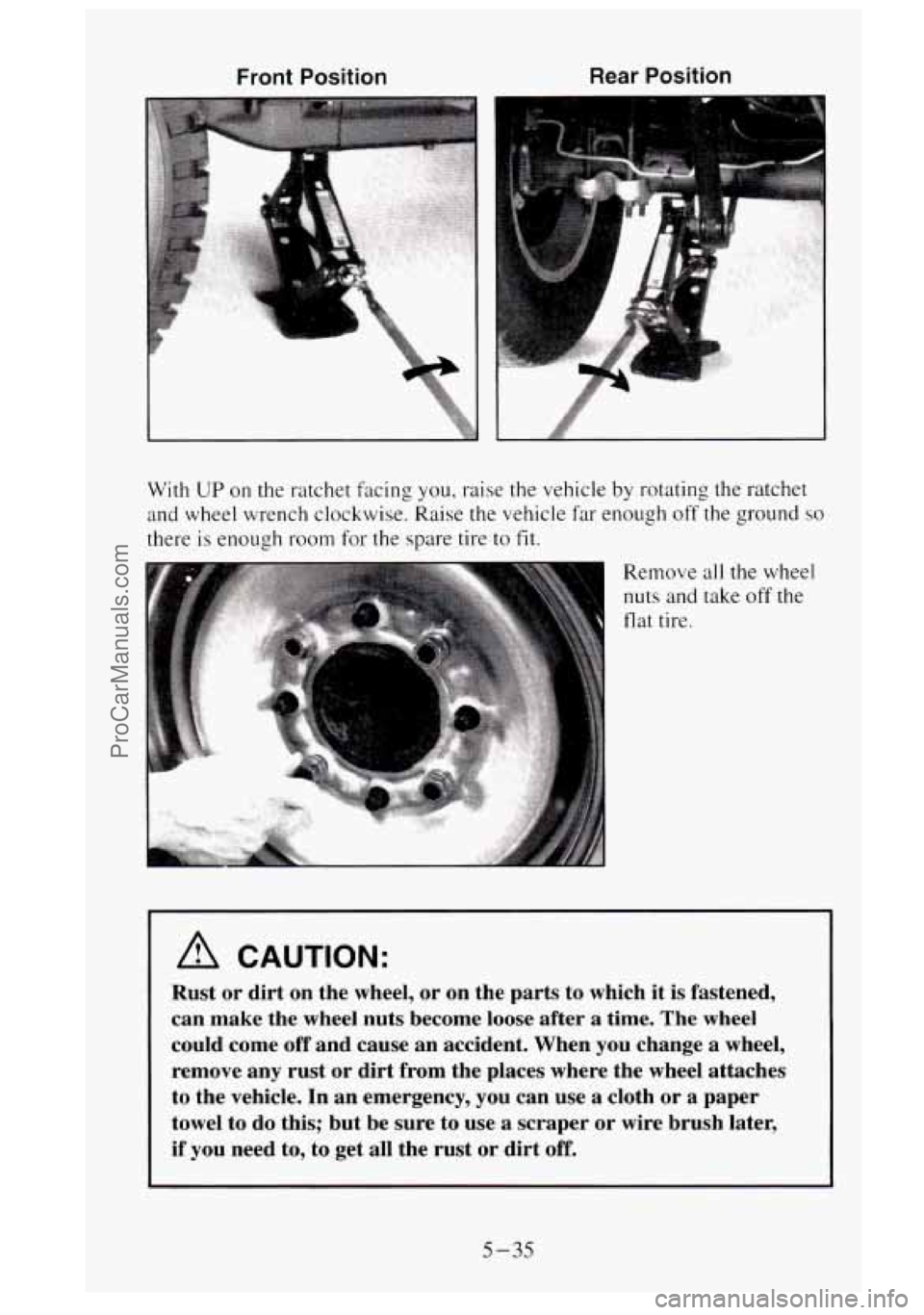
Front rosluon Rear Position
With UP on the ratchet facing you, raise the vehicle by rotating the ratchet
and wheel wrench clockwise. Raise the vehicle
far enough off the ground so
there is enough room for the spare tire to fit.
Remove
all the wheel
nuts and take
off the
flat tire,
A CAUTION:
Rust or dirt on the wheel, or on the parts to which it is fastened,
can make the wheel nuts become loose after a time. The wheel
could come
off and cause an accident. When you change a wheel,
remove any rust or dirt from the places where the wheel attaches
to the vehicle. In an emergency, you can use a cloth or a paper
towel
to do this; but be sure to use a scraper or wire brush later,
if you need to, to get all the rust or dirt off.
5-35
ProCarManuals.com
Page 262 of 488
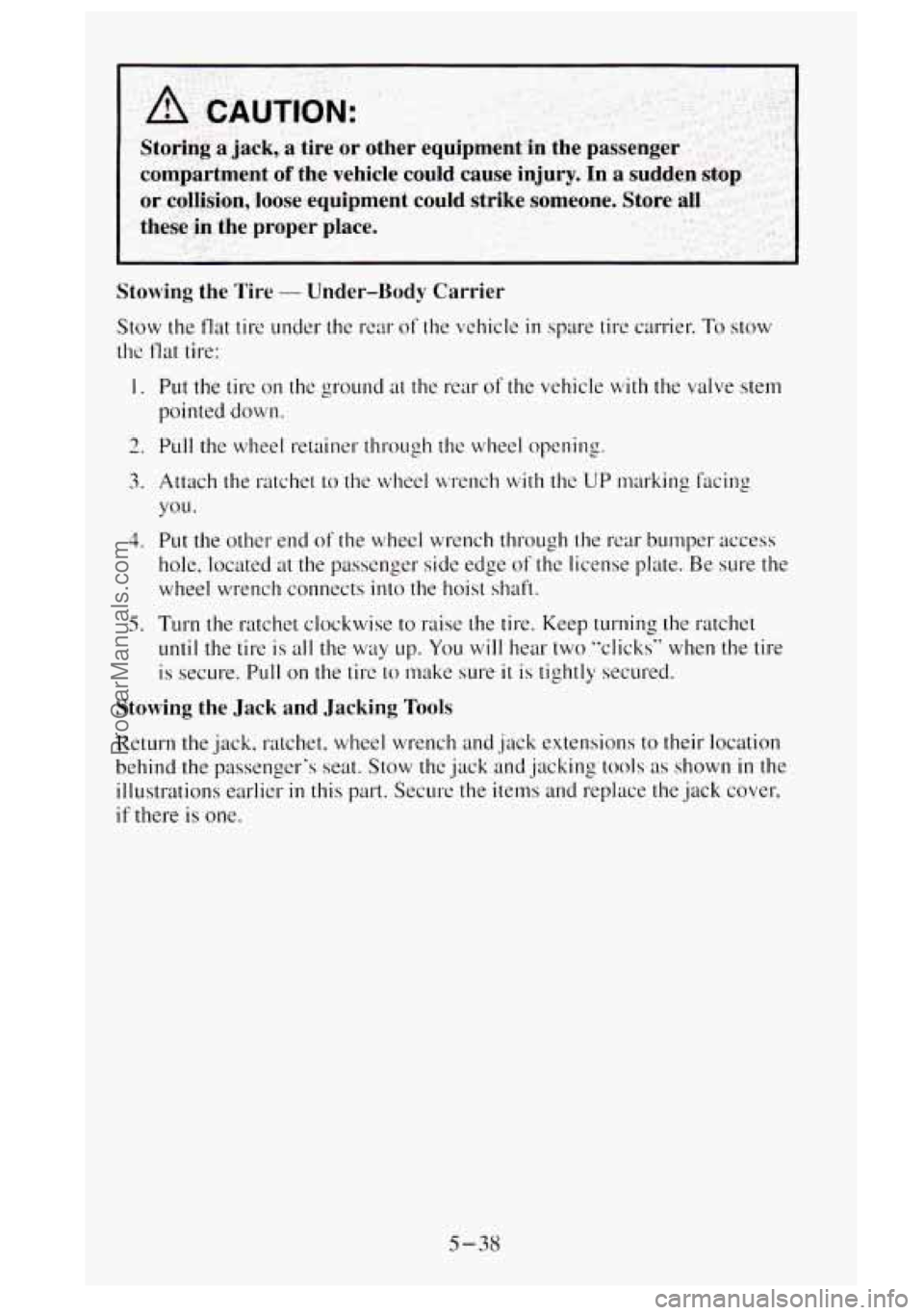
I
A ,CAUTION:
Storing a jack, a tire or other equipment in the passenger
compartment
of the vehicle could cause injury. In a sudden stop
or collision, loose equipment could strike someone. Store all
these
in the proper place.
Stowing the
Tire - Under-Body Carrier
Stow the flat tire under the rwr of the vehicle in spare tire carrier. To stow
the flat tire:
1.
AI 3
3.
4.
5.
Put the tire on the ground at the rear of the vehicle with the valve stern
pointed down.
Pull the wheel retainer through thc wheel opening.
Attach the ratchet
to the urheel n'rench with the UP marking Facing
you.
Put the other end of the whcel wrench through the rcar bumper access
hole, located at the passenger side edge
of the license plate. Be sure the
wheel wrench connects into the hoist
shaft.
Turn the ratchet clockwise to raise the tire. Keep turning the ratchet
until the tire is all the way up. You will hear two "clicks" when the tire
is secure. Pull on the tire to nuke sure it is tightly secured.
Stowing the Jack and Jacking Tools
Return the jack, ratchet, wheel wrench and jack extensions to their location
behind the passenger's
seat. Stow thc jack and jacking tools as shown in the
illustrations earlier
in this part. Secure the items and replace the jack cover,
if there is one.
5-38
ProCarManuals.com
Page 324 of 488
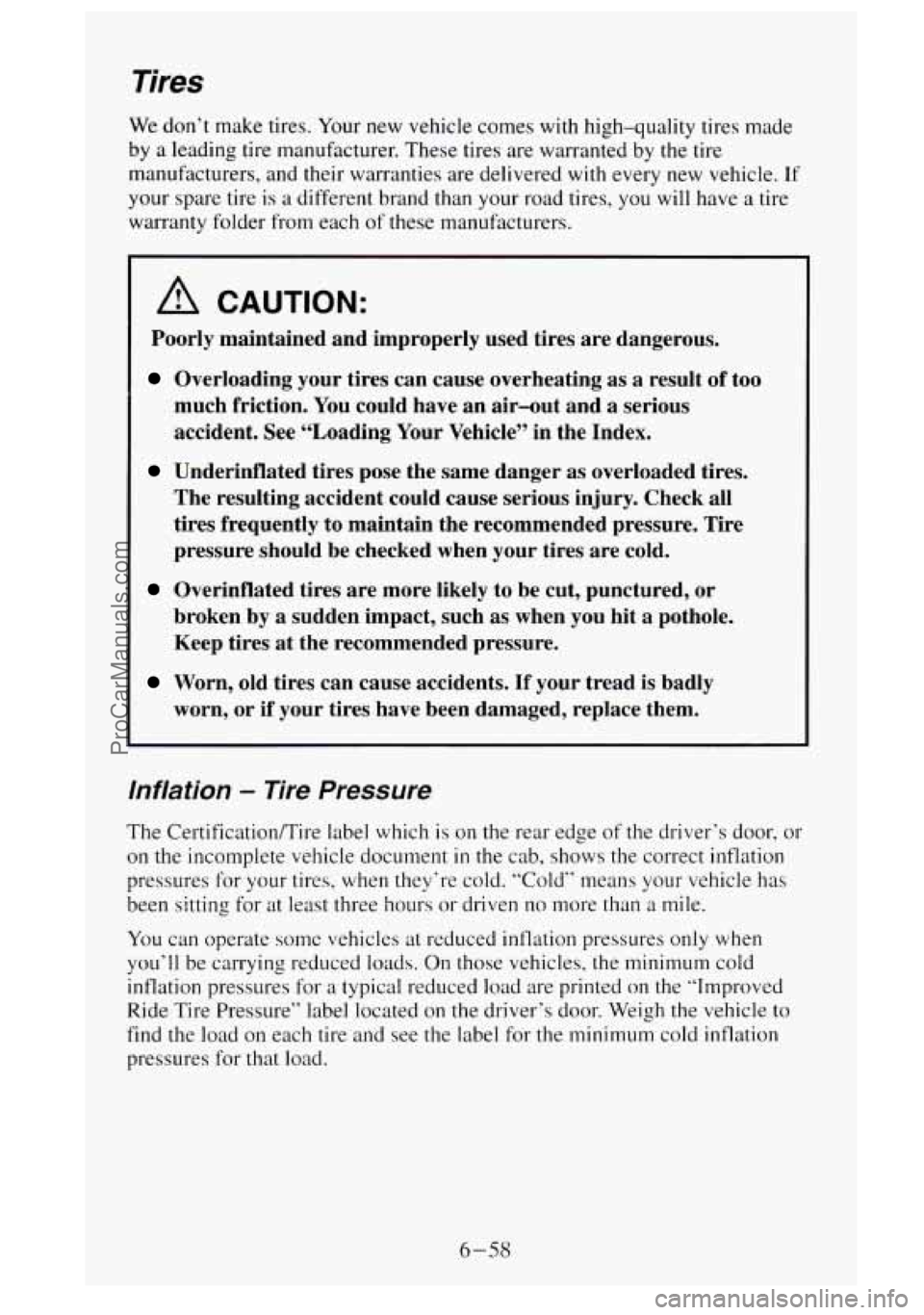
Tires
We don’t make tires. Your new vehicle comes with high-quality tires made
by a leading tire manufacturer. These tires are warranted by the tire
manufacturers, and their warranties are delivered
with every new vehicle. If
your spare tire is a different brand than your road tires, you will have
a tire
warranty folder from each
of these manufacturers.
A CAUTION:
Poorly maintained and improperly used tires are dangerous.
Overloading your tires can cause overheating as a result of too
much friction. You could have an air-out and a serious
accident. See “Loading Your Vehicle” in the Index.
Underinflated tires pose the same danger as overloaded tires.
The resulting accident could cause serious injury. Check all
tires frequently to maintain the recommended pressure. Tire
pressure should be checked when your tires are cold.
Overinflated tires are more likely to be cut, punctured, or
broken by
a sudden impact, such as when you hit a pothole.
Keep tires
at the recommended pressure.
Worn, old tires can cause accidents. If your tread is badly
worn, or if your tires have been damaged, replace them.
Inflation - Tire Pressure
The Certification/Tire label which is on the rear edge of the driver‘s door, or
on the incomplete vehicle document in the cab, shows the correct inflation
pressures for your tires, when they’re cold. “Cold“ tneans your vehicle
has
been sitting for at least three hours or driven no more than a mile.
You can operate some vehicles at reduced inflation pressures only when
you’ll be carrying reduced loads. On those vehicles, the minimum cold
inflation pressures for
a typical reduced load are printed on the “Improved
Ride Tire Pressure” label located on the driver’s door. Weigh the vehicle to
find the load on each tire and see the label for the minimum cold inflation
pressures for that load.
6-58
ProCarManuals.com
Page 325 of 488
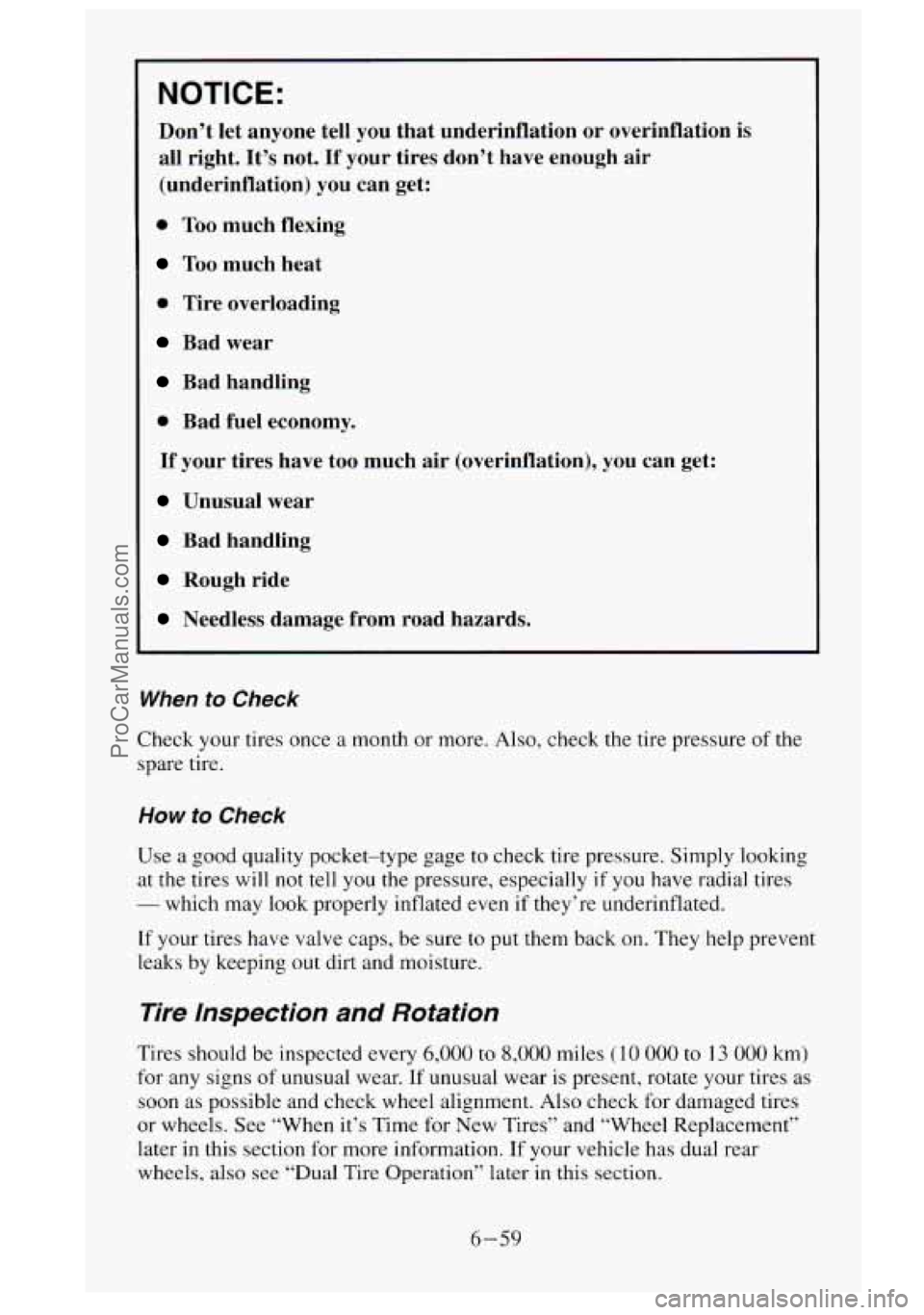
NOTICE:
Don’t let anyone tell you that underinflation or overinflation is
all right. It’s not.
If’ your tires don’t have enough air
(underinflation)
you can get:
0 Too much flexing
Too much heat
0 Tire overloading
Bad wear
Bad handling
0 Bad fuel economy.
If your tires have too much air (overinflation), you can get:
Unusual wear
Bad handling
Rough ride
Needless damage from road hazards.
When to Check
Check your tires once a month or more. Also, check the tire pressure of the
spare tire.
How to Check
Use a good quality pocket-type gage to check tire pressure. Simply looking
at the tires will not tell you the pressure, especially
if you have radial tires
- which may look properly inflated even if they’re underinflated.
If your tires have valve caps, be sure to put them back on. They help prevent
leaks by keeping out dirt and moisture.
Tire Inspection and Rotation
Tires should be inspected every 6,000 to 8,000 miles (10 000 to 13 000 km)
for any signs of unusual wear. If unusual wear is present, rotate your tires as
soon as possible and check wheel alignment. Also check for damaged tires
or wheels. See “When it’s Time for New Tires” and “Wheel Replacement”
later in this section for more information.
If your vehicle has dual rear
wheels, also see
“Dual Tire Operation” later in this section.
6-59
ProCarManuals.com
Page 329 of 488
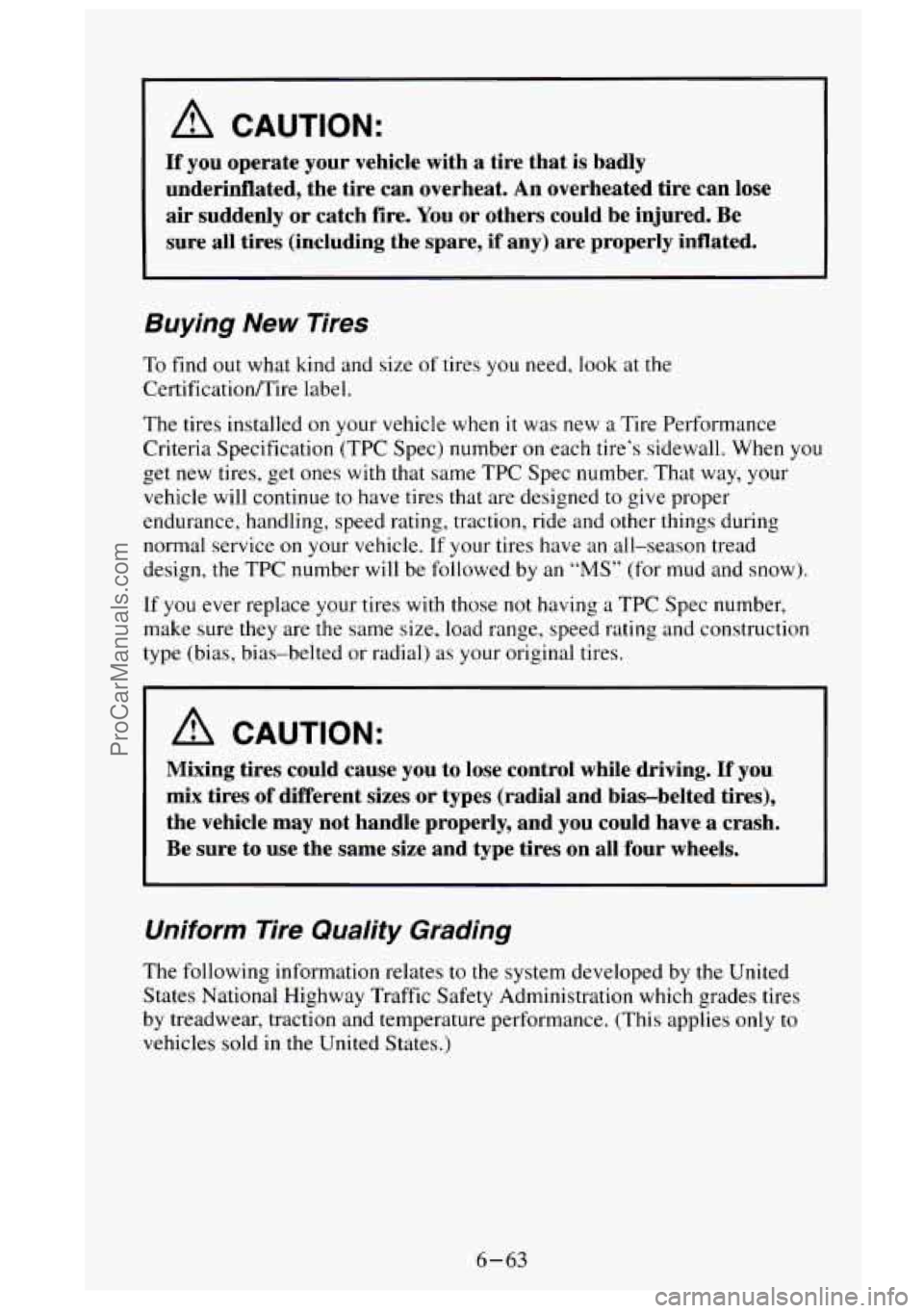
A CAUTION:
If you operate your vehicle with a tire that is badly
underinflated, the tire can overheat. An overheated tire
can lose
air suddenly or catch fire. You or others could be injured. Be
sure all tires (including the spare, if any) are properly inflated.
Buying New Tires
To find out what kind and size of tires you need, look at the
CertificationRire label.
The tires installed on your vehicle when
it was new a Tire Performance
Criteria Specification (TPC Spec) number on each tire’s sidewall. When you
get new tires, get ones with that same TPC Spec number. That way, your
vehicle will continue to have tires that are designed to give proper
endurance, handling, speed rating, traction, ride and other things during
normal service on your vehicle.
If your tires have an all-season tread
design, the TPC number will be followed by an
“MS” (for mud and snow).
If you ever replace your tires with those not having a TPC Spec number,
make sure they are the same. size, load range, speed rating and construction
type (bias, bias-belted or radial) as your original tires.
I A CAUTION:
Mixing tires could cause you to lose control while driving. If you
mix tires of different sizes or types (radial and bias-belted tires),
the vehicle may not handle properly, and you could have
a crash.
Be sure to use the same size and type tires on all four wheels.
Uniform Tire Quality Grading
The following information relates to the system developed by the United
States National Highway Traffic Safety Administration which grades tires
by treadwear, traction and temperature performance.
(This applies only to
vehicles sold in the United States.)
6-63
ProCarManuals.com
Page 465 of 488
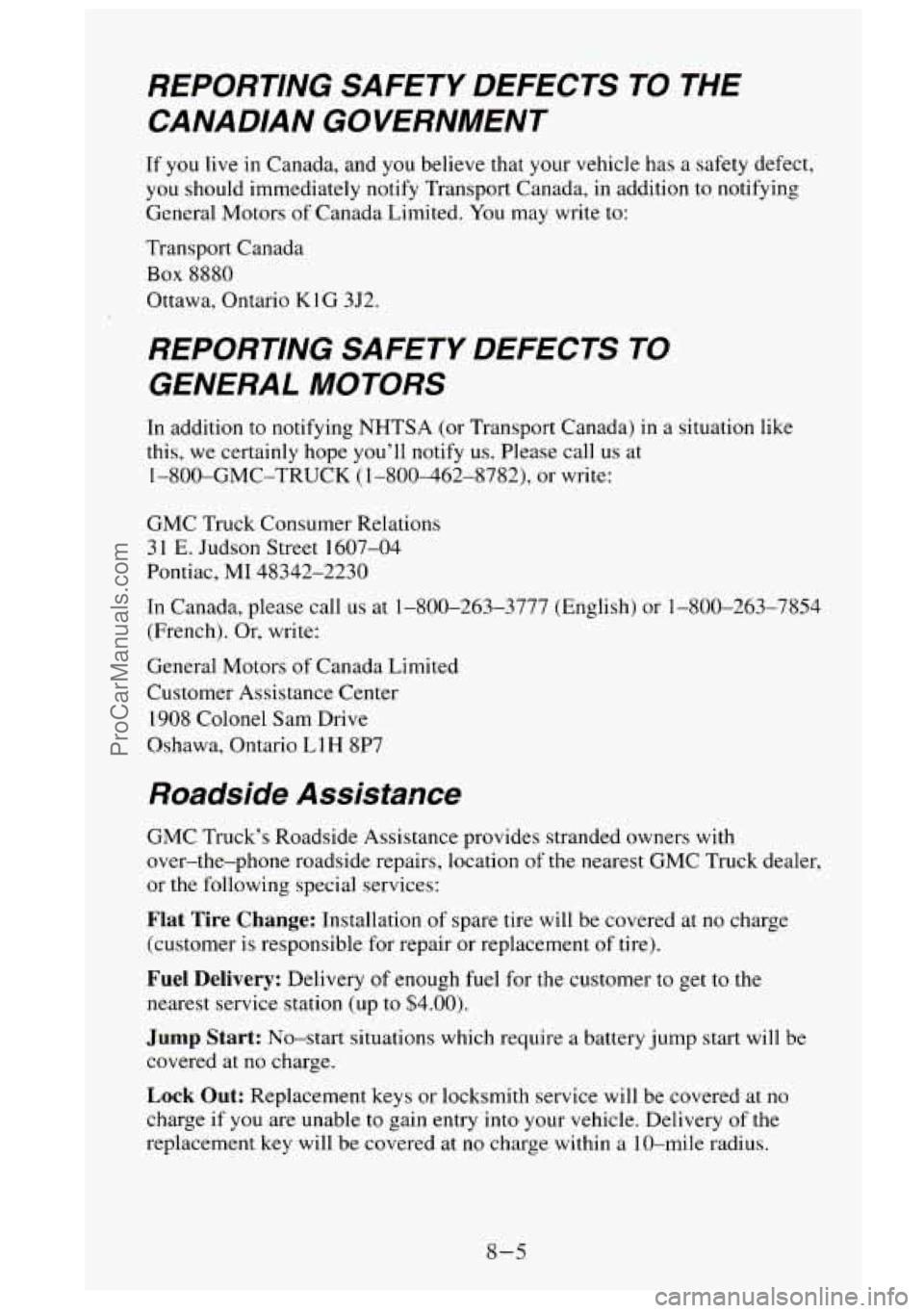
REPORTING SAFETY DEFECTS TO THE
CANADIAN GOVERNMENT
If you live in Canada, and you believe that your vehicle has a safety defect,
you should immediately notify Transport Canada, in addition
to notifying
General Motors of Canada Limited.
You may write to:
Transport Canada
Box 8880
Ottawa, Ontario K1 G 352.
REPORTING SAFETY DEFECTS TO GENERAL MOTORS
In addition to notifying NHTSA (or Transport Canada) in a situation like
this, we certainly hope
you’ll notify us. Please call us at
1-800-GMC-TRUCK (1-800-462-8782), or write:
GMC Truck Consumer Relations
3
1 E. Judson Street 1607-04
Pontiac, MI 48342-2230
In Canada, please call
us at 1-800-263-3777 (English) or 1-800-263-7854
(French). Or, write:
General Motors of Canada Limited
Customer Assistance Center
1908 Colonel Sam Drive
Oshawa, Ontario
LlH 8P7
Roadside Assistance
GMC Truck’s Roadside Assistance provides stranded owners with
over-the-phone roadside repairs, location of the nearest GMC Truck dealer,
or the following special services:
Flat Tire Change: Installation of spare tire will be covered at no charge
(customer
is responsible for repair or replacement of tire).
Fuel Delivery: Delivery of enough fuel for the customer to get to the
nearest service station (up to $4.00).
Jump Start: No-start situations which require a battery jump start will be
covered at
no charge.
Lock Out: Replacement keys or locksmith service will be covered at no
charge if you are unable to gain entry into your vehicle. Delivery of the
replacement key will be covered at no charge within a 10-mile radius.
8-5
ProCarManuals.com
Page 481 of 488

Seats (continued) Reclining Front Seatbacks
....................................... 1-3
Seatback Latches
........................................... 14. 1-8
Doing Your Own Service Work ................................... 6-1
Parts Identification Label
.....................
Service
Publications
.................................
Replacement Parts and Filter Recommendations ....
Service Engine Soon Light (See “Lights”)
Servicing Your Air Bag-Equipped Vehicle (See “Supple
System (SIR)”)
Shift Indicator Light (See *‘Lights“)
Shifting Into Park (P)
...........................
Shifting Out of Park .............................
Shock Absorbers (Front) .........................
.................. 6-78
.................. 8-8
....... 6-80.6-84,6-85
:r nental Inflatable Restraint
................. 2-28
................. 2-29
................. 6-45
Specifications Chart (See “Service . Replacement Parts and Filter
Recommendations“) SpareTire
................................................. 5-28.5-29
Speedometer and Odometer (See “Gages”)
Starting Your Engine (See ”Engine-Starting”)
Steering
........................................................ 4-7
Column Shift Lever
............................................ 2-29
InEmergencies
................................................ 4-8
Tips
......................................................... 4-7
Step-Bumperpad ................................................ 2-84
Storage Compartments
............................................ 2-59
Sunvisors
..................................................... 2-57
Supplemental Inflatable Restraint System (SIR)
........................ 1-19
Adding Equipment to Your Facial Air Bag-Equipped Vehicle
.......... 1-23
How the Air Bag System Works .................................. 1-20
Servicing Your Air Bag-Equipped Vehicle
......................... 1-23
Surge Tank Pressure Cap
.......................................... 6-39
T
Tachometer (See “Gages”)
Tail~ate
......................................................... 2-4
Removal ..................................................... 2-4
TIleft ........................................................... 2-8
Thermostat
..................................................... 6-40
Tilt Wheel (Option) .............................................. 2-38
Tires
.......................................................... 6-58
Balancing (See “Wheel Alignment and Tire Balance”)
Chains
...................................................... 6-66
Dual Tire Operation ........................................... 6-62
Flat (See ”Changing
a Flat Tire”)
Inspection and Rotation
........................................ 6-59
Loading (See “Loading Your Vehicle”)
New
........................................................ 6-63
Pressure
..................................................... 6-58
Spare (See ”Spare Tire”)
Uniform Tire Quality Grading
................................... 6-63
Top Strap (See “Safety Belts-Child Restraints“)
Torque Lock (See “Transmission-Torque Lock“)
9
ProCarManuals.com